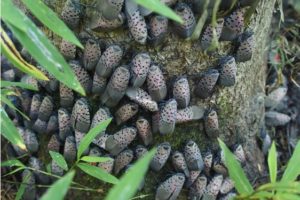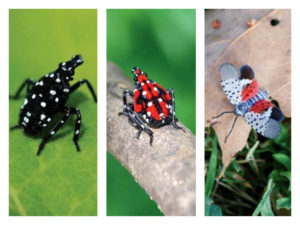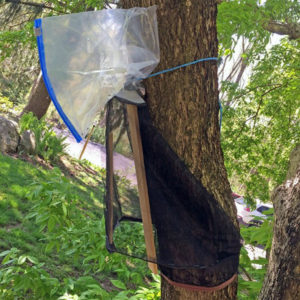Lanternflies: The Grownups Are Here
August 9th, 2022
Though the spotted lanternfly has been annoying a lot of central-Pennsylvania gardeners for two or three years now, not everyone has experienced the misfortune yet of hosting this new Asian import in their yard.

Spotted lanternflies often congregate in numbers like these.
Credit: Penn State Extension
Be ready. You may be about to meet them for the first time.
Lanternflies morph into their adult form starting in late July and really become noticeable in August and September.
This is when they become gray flying insects, about the size of a pinky tip, with black spots on the wings. When they go to fly, they open a second set of wings that reveal a distinctive red-orange color with black spots.
Although they don’t technically “swarm,” they do tend to show up in rather large masses – enough to almost blanket the ground in some cases.
One oddity about their behavior is that they can be really numerous in one area one year but then seemingly disappear the next. Or they’ll be all over one neighborhood but not in another one nearby.

Three different life-stage looks of the spotted lanternfly.
Credit: Penn State Extension
I think that a lot of gardeners/yardeners are going to experience adult lanternflies for the first time this year because a lot of people earlier this summer were wondering about strange new little crawling and hopping black bugs with white spots.
A few weeks ago, the mystery was little crawling/hopping red bugs with white spots and black trim.
Both of these were the nymphal stages of the grownup lanternflies we’ll be seeing this month.
Since the nymphs don’t look much like adult lanternflies, it’s no wonder first-timers didn’t make the connection. But once you’ve seen the nymphs and the adults in action, both stages are pretty memorable.
The adults fly around, mate, and lay eggs on trees and other objects from late summer into November before dying for the season. The eggs survive through winter, then hatch next spring to start a whole new cycle.
Penn State entomologists believe that the year-to-year, neighborhood-by-neighborhood fluctuations are influenced by the availability of favorite plants, natural enemies, and even weather.
Adult lanternflies are fond of grapes, river birch, willow, sumac, silver and red maples, and especially the invasive tree-of-heaven. Home gardeners have reported nymphs on cucumber, basil, rose, peony, and Russian sage – up to a total of at least 70 species altogether.
While hordes of lanternflies and their resulting “honeydew” (liquid waste) are an undoubted nuisance, this bug isn’t a widespread plant-killer.
The biggest exception is the damage they do on grapes. However, lanternflies do have the potential to cause damage on landscape plants that already are stressed by other problems… and when heavy feeding occurs several years in a row.
For those reasons, Penn State Extension advises treatment decisions on a case-by-case basis.
One option is doing nothing since the bugs don’t sting, bite, or transmit disease and probably aren’t going to decimate a landscape.
A second option is trapping lanternflies as they move up and down trees to feed. “Circle traps” and sticky bands with wildlife barriers are two DIY choices.

This is what a DIY lanternfly circle trap looks like.
Credit: Emilie Swackhamer/Penn State
See Penn State’s illustrated, step-by-step fact sheet on how to make a circle trap
A third option – if you have the time, patience, and “ick-factor” tolerance – is squishing lanternflies one by one.
And a fourth option is insecticides.
According to Penn State Extension, effective sprays include organics such as insecticidal soap, neem oil, horticultural oil, and natural pyrethrins as well as the synthetic insecticides bifenthrin, beta-cyfluthrin, carbaryl, malathion, and zeta-cypermethrin.
For killing lanternflies higher up in trees, Penn State lists two systemic chemicals – a soil drench that homeowners can buy containing imidacloprid and the chemical dinotefuran that professionals can apply via trunk spray, soil drench, or trunk injection.
Come fall through winter, scraping/squashing egg masses is a fifth control option.
Penn State Extension has an excellent Spotted Lanternfly Management Guide that includes photos, details on the various controls, and a rundown to help residents decide whether to treat or not.







